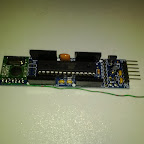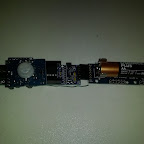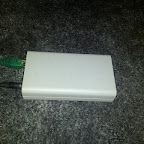Home Monitoring
Over the past few months I’ve been slowly stocking up on all the equipment needed to properly get back into electronics. As I was gathering things together I discovered Arudinos. These are an easy entry into microcontrollers, much simpler in my opinion to PICs, and cheaper than most other developers kits. The fact that they’re open source and open hardware just seals the case. The standard Arudinos are rather nice to work with, but since messing with them on a few mini projects to teach myself about them, I came across a guy who was selling his own custom design, utilising the arduino bootloader and interface, but in a much smaller form factor and inbuilt wireless communications.
These JeeNodes are about the size of a pendrive, and have an inbuilt RF12B wireless module. Along with the nice hardware design, there are also some easy to use libraries, and a great website to accompany them, with lots of nice tutorials, information, and general geekiness.
So, where does home monitoring come into this? One of the addon boards that Jeelabs sell are little room monitoring nodes that detect temperature, humidity, and light level. Add a PIR and you’ve got a motion sensor too. The guy behind the JeeNodes, Jean-Claude Wippler, has done some great work on power consumption meaning that these room nodes can run off a single AA battery for nearly a year. There are about a dozen or so of these nodes now spread across my house, logging into a database, and I’ve done some basic graphs to display the data.
Now I’d also noticed another project using arduinos to monitor electric consumption that was also based on JeeNodes, and reporting back to a central server to log into a database. This got me thinking, could I combine these, and maybe more. The beauty of open source is the fact you can tweak and edit to your hearts content. The fact that both these projects used JeeNodes, and more importantly, the RF12B library from JeeLabs, means that I only need one receiving station and a few small edits to the nodes.
To the transmissions I added a node type to the beginning of the data. This defined whether the node was a room node, power node, or any other future node types I may define. Most of the rest of the code was left untouched, except to assign a node number to each node. That was the easy bit.
Next I needed a receiving station, and some way to get the data it received into a database. For this I once again turned to the JeeNode. Handily, JeeLabs also sell a nice case for the JeeNode, along with a Ethernet add on. This gives me a very small self contained module that simply needs power, and an ethernet connection. Both the energy monitor project, and the room node project had their own code for a base station, and for getting the data into the database. In the best traditions of open source, I have stolen from both these projects and combined my favourite ideas out of both.
The houseNode sits and listens for any broadcasts from any nodes. It knows about the different types of nodes, and the data structure to be expected for those nodes. When a data packet is received then the node type is stripped out, and the rest of the data put into a structure definition depending on the type. Then a JSON structure is constructed, and sent via HTTP POST to a web server. No acknowledgements of data being received are currently sent, but with future expansions that I have in mind, this will be a requirement.
The web server will receive the POST command, and basically dump this information into a database. From this database, a front end can draw graphs and report on anything you want. The front end is very much still in construction, but can be viewed at http://home.22balmoralroad.net/
Future developments I am considering are a thermostat node, to control our central heating, and RFID entry/exit nodes to log in and out of the house. The RF12B modules have a limit of 32 addresses, two of which are reserved. However, 30 nodes should be enough for most of my ideas! It does have the other benefits of very low power, very simple, and the JeeLabs library even has encryption built in. Below are the Arduino sketches for each of the nodes.




Leave a Reply